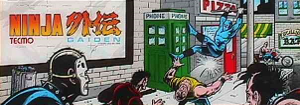ThatLuciano (talk | contribs) m (added game disambig for xbox version) |
ThatLuciano (talk | contribs) m (also added a series disambig) |
||
| Line 12: | Line 12: | ||
}} | }} | ||
{{Series disambig}} | |||
{{game disambig||{{c|NES}} version|[[Ninja Gaiden (NES)]]}} | {{game disambig||{{c|NES}} version|[[Ninja Gaiden (NES)]]}} | ||
{{game disambig||{{c|Xbox}} version and all newer revisions|[[Ninja Gaiden (Xbox)]]}} | {{game disambig||{{c|Xbox}} version and all newer revisions|[[Ninja Gaiden (Xbox)]]}} | ||
Revision as of 05:32, 15 September 2012
- For NES version, see Ninja Gaiden (NES).
- For Xbox version and all newer revisions, see Ninja Gaiden (Xbox).
Ninja Gaiden is an arcade game released in 1988 in North America by Tecmo. This game is known in Japan as Ninja Ryūkenden (忍者龍剣伝 Legend of the Ninja Dragon Sword?) and in Europe as Shadow Warriors.
In North America, it saw domestic releases on the Atari Lynx and PC (DOS based) as Ninja Gaiden. In Europe, it was released for the Amstrad CPC, Commodore 64, Commodore Amiga and ZX Spectrum as Shadow Warriors. The Atari Lynx version was also released in Europe, keeping its North American name, Ninja Gaiden.
It also inspired an action platform game for the Nintendo Entertainment System bearing the same name.
Ninja Gaiden also appeared as an unlockable bonus feature on the Xbox game that relaunched the series in 2004. Template:Continue Nav The arcade version of Ninja Gaiden is closer to the beat 'em up genre, similar in style to Double Dragon. The game stars a nameless ninja on a quest to defeat an evil cult led by a (fictional) descendant of Nostradamus. Upon starting the game, the player is greeted by the phrase "NINJA IN USA." The game can be played alone or cooperatively with a second player (who plays as a red-clad ninja).
In this game, the player's character must trek across the United States to fight several enemies along the way. The player must also use ninja tactics to get through some areas. For example, in some levels, the player must perform acrobatic stunts to get from one area to another via overhanging lights or poles. Also, from time to time, the player must perform a Tightrope Walk across poles, which requires the use of the button on top of the joystick.
This game is mostly remembered for two specific reasons. One reason is the absurd difficulty, as several enemies can be on screen at the same time, making it difficult to move. The game also throws players back to certain "check-points" in a level when they die; forcing them, in some instances, to fight through immensely difficult scenarios again. The other reason is its morbid and gruesome continue screen, where the main character is tied to a table while a saw is being lowered towards him.
-
Japanese arcade flyer.
-
ZX Spectrum cover.


